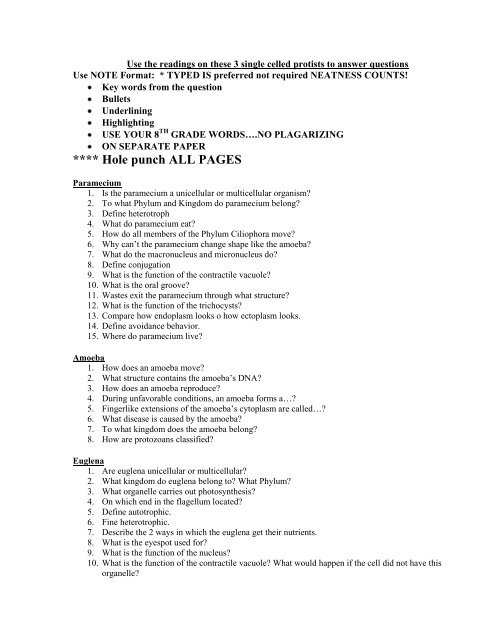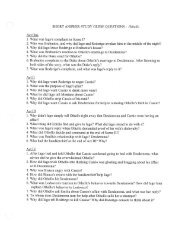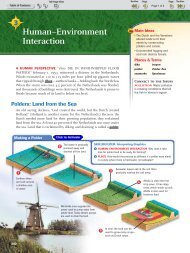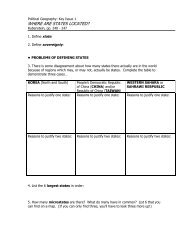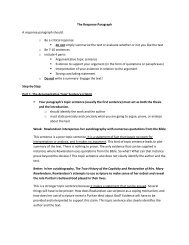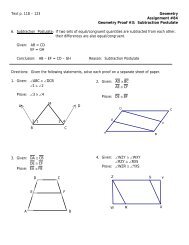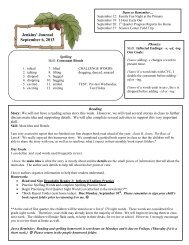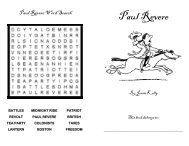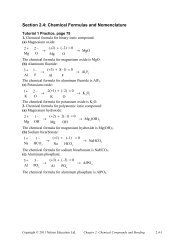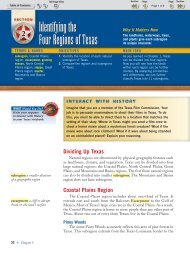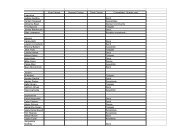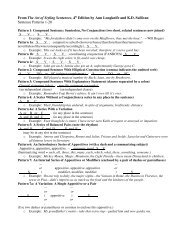Protist Packet - Teacher
Protist Packet - Teacher
Protist Packet - Teacher
Create successful ePaper yourself
Turn your PDF publications into a flip-book with our unique Google optimized e-Paper software.
Use the readings on these 3 single celled protists to answer questions<br />
Use NOTE Format: * TYPED IS preferred not required NEATNESS COUNTS!<br />
Key words from the question<br />
Bullets<br />
Underlining<br />
Highlighting<br />
USE YOUR 8 TH GRADE WORDS….NO PLAGARIZING<br />
ON SEPARATE PAPER<br />
**** Hole punch ALL PAGES<br />
Paramecium<br />
1. Is the paramecium a unicellular or multicellular organism?<br />
2. To what Phylum and Kingdom do paramecium belong?<br />
3. Define heterotroph<br />
4. What do paramecium eat?<br />
5. How do all members of the Phylum Ciliophora move?<br />
6. Why can’t the paramecium change shape like the amoeba?<br />
7. What do the macronucleus and micronucleus do?<br />
8. Define conjugation<br />
9. What is the function of the contractile vacuole?<br />
10. What is the oral groove?<br />
11. Wastes exit the paramecium through what structure?<br />
12. What is the function of the trichocysts?<br />
13. Compare how endoplasm looks o how ectoplasm looks.<br />
14. Define avoidance behavior.<br />
15. Where do paramecium live?<br />
Amoeba<br />
1. How does an amoeba move?<br />
2. What structure contains the amoeba’s DNA?<br />
3. How does an amoeba reproduce?<br />
4. During unfavorable conditions, an amoeba forms a…?<br />
5. Fingerlike extensions of the amoeba’s cytoplasm are called…?<br />
6. What disease is caused by the amoeba?<br />
7. To what kingdom does the amoeba belong?<br />
8. How are protozoans classified?<br />
Euglena<br />
1. Are euglena unicellular or multicellular?<br />
2. What kingdom do euglena belong to? What Phylum?<br />
3. What organelle carries out photosynthesis?<br />
4. On which end in the flagellum located?<br />
5. Define autotrophic.<br />
6. Fine heterotrophic.<br />
7. Describe the 2 ways in which the euglena get their nutrients.<br />
8. What is the eyespot used for?<br />
9. What is the function of the nucleus?<br />
10. What is the function of the contractile vacuole? What would happen if the cell did not have this<br />
organelle?
Ameba Reading<br />
The ameba is a protozoan that belongs to the Kingdom <strong>Protist</strong>a. The name ameba comes from the<br />
Greek word amoibe, which means change. (Amoeba is also spelled ameba.) <strong>Protist</strong>s are<br />
microscopic unicellular organisms that don't fit into the other kingdoms. Some protozoans are<br />
considered plant-like while others are considered animal-like. The ameba is considered an animallike<br />
protist because it moves and consumes its food. <strong>Protist</strong>s are classified by how they move, some<br />
have cilia or flagella, but the ameba has an unusual way of creeping along by stretching its<br />
cytoplasm into fingerlike extensions called pseudopodia. (The word "pseudopodia" means "false<br />
foot".) When looking at ameba under a microscope, an observer will note that no ameba looks the<br />
same as any other, the cell membrane is very flexible and allows for the ameba to change shape.<br />
Amebas live in ponds or puddles, and can even live inside people.<br />
There are two types of cytoplasm in the ameba, the darker cytoplasm toward the interior of the<br />
protozoan is called endoplasm, and the clearer cytoplasm that is found near the cell membrane is<br />
called ectoplasm. By pushing the endoplasm toward the cell membrane, the ameba causes its body<br />
to extend and creep along. It is also by this method that the ameba consumes its food. The<br />
pseudopodia extend out and wrap around a food particle in a process call phagocytosis. The food is<br />
then engulfed into the ameba and digested by the enzymes contained in the ameba's lysosomes. As<br />
the food is digested it exists in a structure called a food vacuole.<br />
Also visible in the ameba is the nucleus, which contains the ameba's DNA. In order to reproduce<br />
the ameba goes through mitotic division, where the nucleus duplicates its genetic material and the<br />
cytoplasm splits into two new daughter cells, each identical to the original parent. This method of<br />
reproduction is called binary fission. Another structure easily seen in the ameba is the contractile<br />
vacuole, who's job is to pump out excess water so that the ameba does not burst.<br />
During unfavorable conditions, the ameba can create a cyst, this hardwalled body can exist for a<br />
long period of time until conditions become favorable again. At this point it opens up and the<br />
ameba emerges. Often cysts are created during cold or dry periods where the ameba could not<br />
survive in its normal condition.<br />
Amebas can cause disease. A common disease caused by the ameba is called Amebic Dysentery. A<br />
person becomes infected by drinking contaminated water. The ameba then upsets the person's<br />
digestive system and causes cramps and diarrhea. A person is most likely to be infected in countries<br />
where the water is not filtered or purified.
Name__________________________period____________<br />
Amoeba To Color<br />
COLOR THE ABOVE “BUBBLE WORDS “THE SAME COLOR YOU COLORED THE<br />
PART.
Paramecium Reading<br />
Paramecium are unicellular protozoans classified in the phylum Ciliophora (pronounced<br />
sill-ee-uh-FORE-uh), and the Kingdom <strong>Protist</strong>a. They live in quiet or stagnant ponds and<br />
are an essential part of the food chain. They feed on algal scum and other<br />
microorganisms, and other small organisms eat them. All members of the Phylum<br />
Ciliophora move by tiny hair-like projections called cilia. Color all cilia black.<br />
The paramecium cannot change its shape like the ameba because it has a thick outer<br />
membrane called the pellicle. The pellicle surrounds the cell membrane. Color the<br />
pellicle light blue.<br />
There are two types of nuclei (plural of nucleus). The large nucleus is called the<br />
macronucleus which controls respiration, protein synthesis and digestion. Color the<br />
macronucleus red. The much smaller micronucleus is used only during reproduction,<br />
color the micronucleus pink. Reproduction in paramecium involves the exchanging of<br />
DNA within the micronucleus. In order to do this, two paramecium lie side by side and join<br />
at the mouth pore. This process is called conjugation and is a method of sexual<br />
reproduction in other microorganisms.<br />
Contractile vacuoles are used in animal cells to remove the excess water. The contractile<br />
vacuole is shaped like a star - color the contractile vacuole dark green.<br />
Paramecium are heterotrophs, meaning they must consume food for their energy. Food<br />
enters the paramecium through the mouth pore (color orange) and goes to the gullet<br />
(color dark blue). At the end of the gullet, food vacuoles are formed. Food vacuoles then<br />
remain in the cytoplasm until the food is digested. Color all food vacuoles light brown.<br />
Undigested food particles are eliminated through the anal pore (color dark brown). The<br />
indented area where food enters the paramecium is referred to as the oral groove.<br />
Paramecium can respond to temperature, food, oxygen and toxins and have a very simple<br />
defense mechanism. Just inside the pellicle are threadlike organelles called trichocysts.<br />
The paramecium can shoot tiny threads out of the cell to entangle a predator or to make<br />
themselves appear bigger. Color the trichocysts purple. Paramecium are also known to<br />
exhibit avoidance behavior. This is where the paramecium will move away from a negative<br />
or unpleasant stimulus.<br />
There are 2 kinds of cytoplasm in the paramecium. The cytoplasm around the edges is<br />
clear and is called ectoplasm. Leave the ectoplasm clear. The rest of the cytoplasm is<br />
more dense is called endoplasm. Color the endoplasm yellow.
Name_______________________ Period___________Paramecium To Color<br />
1. Cilia<br />
2. Pellicle<br />
3. Macronucleus<br />
4. MicroNucleus<br />
5. Contractile<br />
Vacuole<br />
6. Mouth Pore<br />
7. Gullet<br />
8. Food Vacuole<br />
9. Anal Pore<br />
10. Trichocysts<br />
11. Ectoplasm<br />
12. Endoplasm
The Euglena Reading<br />
Euglena are unicellular organisms classified into the Kingdom <strong>Protist</strong>a, and the Phylum<br />
Euglenophyta. All euglena have chloroplasts and can make their own food by<br />
photosynthesis. They are not completely autotrophic though, euglena can also absorb<br />
food from their environment; euglena usually live in quiet ponds or puddles.<br />
Euglena move by a flagellum (plural ‚ flagella), which is a long whip-like structure that acts<br />
like a little motor. The flagellum is located on the anterior (front) end, and twirls in such a<br />
way as to pull the cell through the water. It is attached at an inward pocket called the<br />
reservoir. Color the reservoir grey and the flagellum black.<br />
The Euglena is unique in that it is both heterotrophic (must consume food) and autotrophic<br />
(can make its own food). Chloroplasts within the euglena trap sunlight that is used for<br />
photosynthesis, and can be seen as several rod like structures throughout the cell. Color<br />
the chloroplasts green. Euglena also have an eyespot at the anterior end that detects<br />
light, it can be seen near the reservoir. This helps the euglena find bright areas to gather<br />
sunlight to make their food. Color the eyespot red. Euglena can also gain nutrients by<br />
absorbing them across their cell membrane, hence they become heterotrophic when light<br />
is not available, and they cannot photosynthesize.<br />
The euglena has a stiff pellicle outside the cell membrane that helps it keep its shape,<br />
though the pellicle is somewhat flexible and some euglena can be observed scrunching up<br />
and moving in an inchworm type fashion. Color the pellicle blue.<br />
In the center of the cell is the nucleus, which contains the cell's DNA and controls the cell's<br />
activities. The nucleolus can be seen within the nucleus. Color the nucleus purple, and<br />
the nucleolus pink.<br />
The interior of the cell contains a jelly-like fluid substance called cytoplasm. Color the<br />
cytoplasm light yellow. Toward the posterior of the cell is a star-like structure: the<br />
contractile vacuole. This organelle helps the cell remove excess water, and without it the<br />
euglena could take in some much water due to osmosis that the cell would explode. Color<br />
the contractile vacuole orange.
Name _____________________Period______________<br />
Color the Euglena according to the directions. Organelles can be identified based on their<br />
descriptions<br />
and locations


